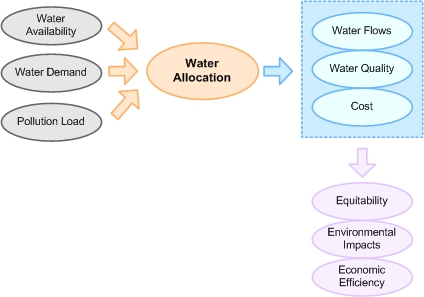The GIS Decision Support System developed aims to assess the state of a water resources system in terms of sources, usage, water cycles (pathways) and environmental quality in a simulation environment that responds realistically to external and internal modifications. It has the potential to evaluate the effects of actions and measures taken during the simulation, on the basis of the different scenarios, alternatives and policies (Table 1).
Within the simulation, water resources are allocated according to a set of demand and supply priorities reflecting the pricing system, social preferences, environmental constraints and development priorities. The Decision Support System assesses water systems based on the three principles of Integrated Water Resources Management:
- Economic efficiency,
- Equitability, and
- Environmental sustainability.
Table 1. Summary of DSS capabilities
|
Estimation of water availability |
| Estimation of the existing and projected water demands |
| Determination of the necessary interventions, their timeframe and cost |
| Determination of the optimal water allocation to uses |
|
| Ranking of scenarios based on indicators |
|
Estimation of the Rate of Cost Recovery, and of the Direct, Environmental and Resource Costs |
There are many ways of classifying implementation approaches or policy options but of special importance for the Decision Support System are the social system responses conceived as comprised of four types of measures:
-
Supply measures, intended to increase available water quantities during drought.
- Measures aimed at decreasing water demands through various conservation techniques and use limitations.
- Measures needed to mitigate impacts.
- Methods able to produce strategies for management through mixes of control measures seeking optimum (efficient and effective) solutions.
The main instruments, also called "Policy Options" for the purposes of the project, used for developing IWRM strategies in the selected Case Studies that are being analysed in their application by the DSS include:
-
Supply management through structural interventions which attempt to enhance fresh water supply (traditional or pioneering ones such as desalination or water reuse).
-
Demand management through reduction of losses, diminishing of overconsumption.
-
Finally, socio-economic instruments such as: Pricing, and Changing of developmental regional priorities.
The DSS can model conditions in a given area/region and be used to estimate how much water is needed to cover the existing and projected demand, to determine what interventions are necessary, as well as when and where, and their cost (Figure 1). It can provide indicators of performance for selected actions under each potential availability and demand scenario, and rank all available scenarios based on these indicators. It provides the user with the ability to assess the functionality and performance of the water system within the entire region of application as well as at individual points of demand/interest. The DSS capabilities however do not extend to the assessment of the performance of the managing authority, or the social impacts of the actions applied.

Figure 1. The Decision Support System conceptual model
Top